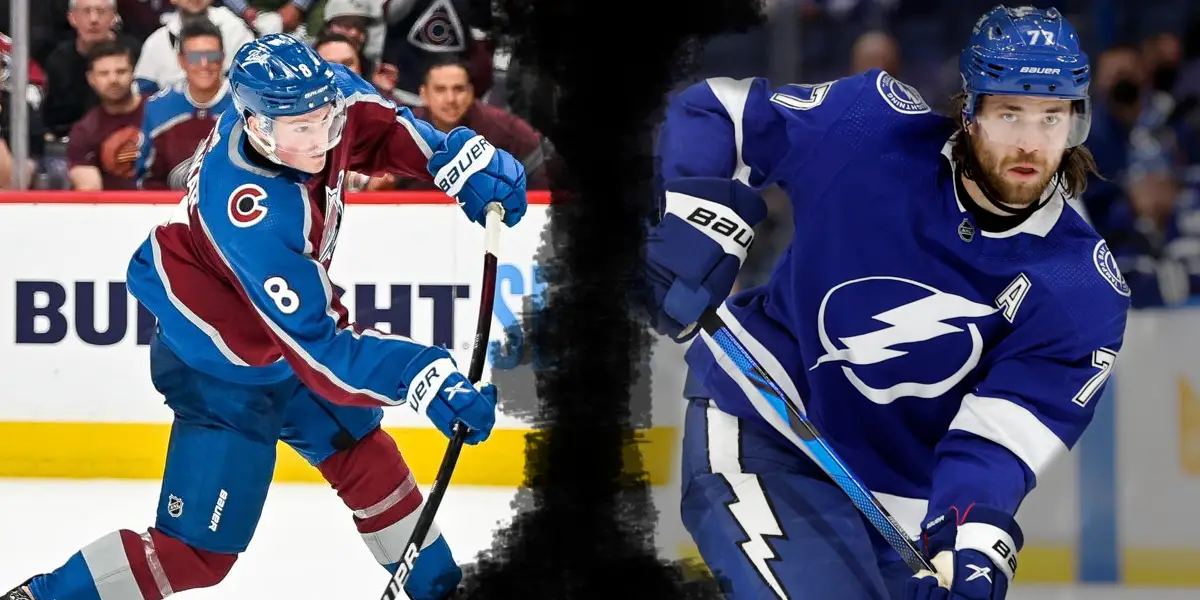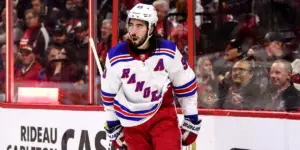
The 2022 Stanley cup playoffs have had three sweeps. All three sweeps belong to the final two teams. Both teams have shown they deserve to be finalists and are the top 2 teams in the league. Both teams have won 4 straight games to move on and have controlled most of their games throughout the playoffs. So how do these teams match up??
Top 6:
TBL:
While Tampa bay’s top line of Palat – Stamkos – Kucherov gets most of the credit, the most important line in their conference finals series was the Hagel – Cirelli – Killorn. According to naturalstattrick.com, in 40 minutes against Zibanejad, the line controlled 82% of the expected goals and allowed no goals against. In their 57:55 of total ice time together, they controlled 76.9% of the expected goals and allowed nothing against. While they haven’t produced any offense, it’s precisely what you need from the line, especially against the top line for Colorado with all their offensive firepower.
The most important player on the line is Anthony Cirelli, who has used his hard work and elite speed to become one of the best shutdown centers in the league. He has been fantastic this postseason, playing most of his time against elite competition.
Another big part of the line is their big deadline acquisition Brandon Hagel, who may not be scoring as much as expected, with only two goals on 5.8 expected goals, which is significantly lower than his regular-season production (22 on 11.8 with CHI and 4 on 5.5 with TBL). Still, he has been a big part of the line and team’s success. He is 2nd on the team in expected goals percentage in the playoffs at 62%, behind only Patrick Maroon. Hagel is another fantastic acquisition, and signed at only 1.5M for another two seasons is precisely what a contending team needs.
While the Lightning are known as a team with great depth scoring, it has really been their top line that has done the damage, mainly on their powerplay. At 5v5, their top line has outscored their opponents 8 to 4, which is their only line with over 30 minutes played that has more goals for than against. Through 17 games, only 9 of Kuecherov’s 23 points have come at 5v5, and only one of his seven goals was at 5v5, but the way the Lightning have been playing, the rest team has been able to cancel out their matchups, allowing for their top players to be the difference in games.
COL:
Colorado can put together one of the best top lines in the league with Landeskog – Mackinnon – Rantanen, and in the 44:58 they have been together these playoffs, they have outscored their opponents 3 – 0. They have controlled 65.1% of the expected goals, but they only have two games these playoffs playing over 4 minutes together, so, for the most part during these playoffs, the top line has been separated. In the series against the Oilers, they matched up McDavid with a line of Nichushkin – Mackinnon – Landeskog, and in the 30:16 at 5v5, the line canceled out McDavid, with four goals for and four goals against, and outscored McDavid 3 – 0 in the rest of the time that at least one of the three was against McDavid. Although there is a good chance they split the line up against the Lightning, especially with the success Landeskog and Lehkonen have had together these playoffs, outsourcing opponents 9 – 2 in 99:18 together and controlling 66.8% of the expected goals, although it might be hard to break up the Lehkonen – Kadri – Rantanen line if Kadri can play.
In the series against the Oilers, the Lehkonen – Kadri – Rantanen line was created and could control 79.4% of the expected goals. But they only ended up even in actual goals with two for and two against in 19:09 before Kadri was taken out of the series by a dirty hit. The two goals came 15 seconds apart, with Kadri and Rantanen combining for a 3rd goal 1:49 after the 2nd goal without Lehkonen on the ice. The large disparity between goals and expected goals is concerning, especially with Mikko Rantanen. During the regular season, with the elite winger on the ice, the Avalanche controlled 1.1 goals above expected per 60, while in the playoffs, they have controlled 0.7 below expected per 60. They have still outscored their opponents with Rantanen on the ice, but both his scoring and the goaltending have been significantly worse in the playoffs. The Oilers series went a long way for Rantanen offensively, as he scored in each game, going from 1 to 5 goals. When he was on the ice, the Avalanche scored 4.3 goals per 60, a massive improvement from the 2.6 goals per 60 in the first two rounds. However, his goals against also massively increased. Rantanen went from allowing just 2.2 goals against per 60 to 4.3 goals against in round 3. It needs to be improved against a Lightning team that will not give nearly as much defensively as the previous three opponents the Avalanche have faced. The good news is Rantanen’s expected goals against did not change as much, going from 1.9 expected goals against per 60 in the first two rounds to 2.2 in the third round, which implies either poor luck or poor goaltending (Most likely both), as expected goals against are proven to be significantly more sustainable than goals against. He has made some strong defensive plays this playoff.
Match ups:
Both teams have incredible top-six talent, with the Lightning having one offensively focused line and one defensively focused, and the Avalanche with two more two-way concentrated lines. Based on the teams’ history of line matching, the Lightning will likely be chasing the Cirelli line against the Avalanche top line. At the same time, the Avalanche will likely target the top line on top line, which could give a home team a significant edge based on how successful each team is at shutting down the other top line.
Bottom 6 Lines:
Both teams have had very strong performances from their 4th lines, and some massive goals from their 3rd line, with both getting two goals in the series-clinching game of their toughest series, from JT Compher for the Avalanche in game 6 of round 2 and Nick Paul for the Lightning in game 7 of round 1. There is a very real possibility that there are games in this series where the top six cancel each other out, and it comes down to which team’s bottom-six can outplay the other.
Forward Injuries:
Both teams are missing a very important center, Point for the Lightning and Kadri for the Avalanche. Point has missed the previous two rounds, and with the success of the Lightning’s top 2 lines and him likely not being at 100%, he could very well find himself on the 3rd line, dominating some easier matchups. Point is the better player between the two, but the Lightning have two other elite centers in Stamkos and Cirelli, making them a lot more capable of handling the loss. On the other hand, Kadri is a big part of Avalanche 2nd line, as they don’t have a clear replacement. Mikko Rantanen did well at center in a small sample size during the regular season, but they moved away from it later in game 4 against the Oilers and went with JT Compher in the spot. Compher is a big step down from Kadri, and they saw the last playoffs against Vegas, and if Kadri isn’t able to play could be detrimental for the Avalanche.
Defense Core:
COL:
Colorado has the best paring in the league with Devon Toews – Cale Makar, and in this playoffs, they have played together for 213:22 and have controlled 60.2% of the expected goals and 59.3% of the goals, playing against top competition. In the series against the Oilers, in 37:18 against Connor McDavid, the pair controlled 54.3% of the expected goals and came out even with four goals for and four against. Makar has 22 points in 14 games, tied for 12th most points all-time by a defenseman, and the players he is tied with are Paul Coffey with 22 in 19 and Victor Hedman with 22 in 25. Makar needs 5 points to pass Miro Heiskanen’s 26 in 27 into 4th most all-time in a playoff run. The pair are both elite skaters with incredible defensive and offensive abilities. They will be essential in both shutting down the lightning offense, transitioning the puck from defense to offense, and creating offense.
The Avalanche 2nd pairing, Bowen Byram – Erik Johnson, started as their 3rd pairing and has been excellent. Both are fantastic skaters and have dominated their matchups, outsourcing their opponents 10 – 3 and controlling 59.6% of the expected goals in 142:24. The pairing has the lowest expected goals against per 60 of any of their pairings at 1.7, and that is exactly what they are going to need if the pairing gets trapped against the Lightnings top line.
The 3rd pairing is where the Avalanche fall off heavily. Coming into the playoffs, the Avalanche had the 2nd pairing of Samuel Girard – Josh Manson. While they both struggled during the regular season, they controlled 51.4% of the expected goals in the playoffs. They were looking really strong in the first two games against the Blues, but after Girard got hurt, there was a significant drop-off in Manson’s partner, with Jack Johnson coming in to replace Girard, who is out for the playoffs. The pairing struggled drastically, controlling only 35.5% of the expected goals. With the success of the other two pairings, Bednar opted to play the two defencemen together and play them very little, relying heavily on their top pairing. In Manson’s first seven games before Johnson was added to the lineup, his average time on ice at 5v5 was 17:11 but averaged just 13:12 after, with Johnson averaging 10:43. The pairing lacks speed and has very little offensive ability. The Lightning are not the fastest team, but they will be able to expose the pairing if it gets stuck out against some of the Lightning’s top players.
TBL:
The Lightning have been much more flexible with their pairings, but their top 4 defencemen in 5v5 time on ice are McDonagh, Sergachev, Hedman, and Cernak. The biggest weakness defensively there is by far Sergachev, who can struggle defensively and make some poor decisions. Still, the other three are some of the top defenders in the league at shutting it down, which is the Lightning’s specialty. Bogosian and Rutta aren’t the strongest defensemen but are always paired up with one of their more potent defensemen, having only played 2:27 together the entire playoffs.
The two most exciting pairings are their offensive duo in Victor Hedman – Mikhail Sergachev and their defensive duo in Ryan McDonagh – Erik Cernak. The offensive paring has been used sparingly, only 33:34 in the playoffs, but they have been highly effective, outscoring their opponents 3 – 1 and controlling 69.2% of the expected goals. The surprising part is they have 6 defensive zone starts and only three offensive zone starts, which is typically the deployment seen from a defensive pairing. The defensive pairing also started primarily in the defensive zone, 19 to 10, and in 99:46 controlled 60.3% of the expected goals. The pairing did get outscored 4 – 2, which does cause some concern, but they have a PDO of 0.937, by far the lowest of the Lightning pairings that have played over 30 minutes. PDO is meant to be a measure of luck. Their low PDO comes from a 3.7% shooting percentage, and a .900 save percentage, which are likely to improve with the shooting talent of the Lightning and their elite goaltender. However, they have only played 7:10 with the Lightnings top line, which will hurt their scoring, but it is their role. They have done it perfectly, best seen by their 57:34 with Anthony Cirelli, where no goals have been scored for either side, but they have controlled 68% of the expected goals.
The Lightning’s most common pairing of Victor Hedman – Erik Cernak takes one from each of the previously mentioned pairings to create a more two-way pairing. In 135:55 together, the pair controlled 52.6% of the expected goals and 50% of the actual goals. However, they only played 6:49 with the top line and played 73:49 with Cirelli with no goals scored for either team, and there is concern that they only generated 44.3% of the expected goals.
Defense Injuries:
Samuel Girard is the only defenceman on either side who is injured, and he has been ruled out for the playoffs, which is a big loss for the Avalanche. Apart from that, both teams should be healthy on the blue line as long as Victor Hedman is okay after a dirty hit by Rangers forward Alexis Lafrenière.
Goaltending:
COL:
On paper, this is the one clear advantage in the series. However, the Avalanche have some hope. In the first two games of this playoff, Darcy Kuemper had saved 1.3 goals above expected, which is perfectly in line with what the Avalanche needed from him. However, he took a stick to the eye in the third game and missed the rest of the series. He returned for round 2, but was significantly worse, with only one game at a positive goals saved above expected and ending the series having allowed 5.1 goals above expected. He left game 1 of the conference finals and didn’t play the rest of the series but is supposedly at 100%. If the Avalanche can get the Kuemper they got from January 1st until the end of the regular season, who saved 18.5 goals above expected, second to only Igor Shesterkin and well above Vasilevskiy’s 5.9 during that period, they should win. Still, if they get the Kuemper from round 2, they are in trouble.
TBL:
This is the area the Lightning should feel most confident. After allowing 2.3 goals above expected in the first six games, Vasilevskiy has saved 13 goals above expected, including a ridiculous 3.94 in the series-clinching game of round 2. His record in series-clinching games is ridiculous and so well known that it could get in the heads of their opponent. One of the most underrated parts of the Lightnings’ 11 straight series wins is their healthy they’ve had two massive injuries, with Stamkos only playing one game their first run and Point missing two rounds this run. Still, outside of that, they haven’t missed many players.
Most importantly, Vasievskiy has been healthy. Vasilevskiy has played 65 straight playoff games in the past three playoff runs to the cup, and it goes to 93 straight if you go back to the 2015-16 conference finals. His health has been incredibly impressive and essential to the Lightning’s success. There is not much to say about him that hasn’t been said, but he will need to be great for the Lightning to win their 3rd straight cup, and he will likely be great once again.
Special Teams:
While the special teams looks even on paper, it is likely an advantage for the Lightning, especially with how penalties are called in the playoffs, likely resulting in an even number of powerplays even though the Lightning will likely cause more infractions. The Lightning have had a potent powerplay while missing an elite powerplay contributor in Brayden Point, who led the last year’s playoffs in powerplay goals with 6. However, the Avalanche penalty kill is coming off a strong performance against the Oilers, while the Lightning struggled against the Rangers’ elite power play. Both teams have elite offensive talents that should cancel out, but if one side falters on the power play, it could lose them the series.
Conclusion:
The Avalanche are a fast team with many strong forecheckers, mobile defencemen, and underrated team defense that can dominate games off the rush or with their forecheck and cycle game. The Lightning are a team that can shut it down if they need to, but also have a deadly attack, from elite passing and shooting, to forechecking and cycling, and they have an elite goalie backstopping them. This could be one of the all-time greatest finals, with both teams having a real shot at winning.
Data via Evolving Hockey & Natural Stat Trick

Stanley Cup Aspirations – Cue’ the Duck Boats Pod
Discover more from Inside The Rink
Subscribe to get the latest posts sent to your email.



